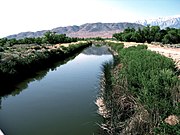http://en.wikipedia.org/wiki/Manzanar_internment_camp#Quenching_Los_Angeles.E2.80.99_thirst
Owens Valley: Quenching Los Angeles’ thirst
Ranchers
When European American white settlers first arrived in the Owens Valley in the mid–19th century, they found a number of large Paiute villages in the Manzanar area.[31] John Shepherd, one of the first of the new settlers, homesteaded 160 acres (65 ha) of land three miles (4.8 km) north of Georges Creek in 1864. With the help of Owens Valley Paiute field workers and laborers,[32] he expanded his ranch to 2,000 acres (810 ha).[33]
In 1905, George Chaffey, an agricultural developer from Southern California, purchased Shepherd's ranch and subdivided it, along with other adjacent ranches. He founded the town of Manzanar in 1910.[8][34] Chaffey's Owens Valley Improvement Company built an irrigation system and planted thousands of fruit trees.[8] By 1920, the town had more than twenty-five homes, a two-room school, a town hall, and a general store.[34] Also at that time, nearly 5,000 acres (2,000 ha) of apple, pear, and peach trees were under cultivation; along with crops of grapes, prunes, potatoes, corn and alfalfa; and large vegetable and flower gardens.[8][35] "Manzanar was a very happy place and a pleasant place to live during those years, with its peach, pear, and apple orchards, alfalfa fields, tree-lined country lanes, meadows and corn fields," said Martha Mills, who lived at Manzanar from 1916 to 1920.[36] Some of the early orchards, along with remnants of the town and ranches, are still present at Manzanar today.[34]

Quenching Los Angeles’ thirst
As early as March 1905, the City of Los Angeles began secretly acquiring water rights in the Owens Valley.[37][38] In 1913 it completed construction of its 233-mile (375 km) Los Angeles Aqueduct,[7] to transport Owens River water diverted to Los Angeles instead of allowing it to drain into Owens Lake.[39][40] But it did not take long for Los Angeles water officials to realize that Owens River water was not enough to supply the rapidly growing metropolis. In 1920, they began to purchase more of the water rights on the Owens Valley floor. As the decade went on, the City of Los Angeles bought out one Owens Valley farmer after another, and extended its reach northward into Mono County, including Long Valley.[41] By 1933, the City owned 85% of all town property and 95% of all ranch and farm land in the Owens Valley, including Manzanar.[34]
Although some residents sold their land for prices that made them financially independent and relocated, a significant number chose to stay. In dry years, Los Angeles pumped ground water and drained all surface water, diverting all of it into its aqueduct and leaving Owens Valley ranchers without water.[42] Without water for irrigation the holdout ranchers were forced off their ranches and out of their communities; that included the town of Manzanar, which was abandoned by 1929.[7] Manzanar remained uninhabited until the United States Army leased 6,200 acres (2,500 ha) from the City of Los Angeles for the Manzanar War Relocation Center.[7]
There was so much water during those early years, that when a horse pulled a buggy, the water frequently came up to the horse's knees," said Lucille DeBoer, who lived on a ranch at Manzanar. "When this happened, the children took off their shoes and socks to walk home. In the early 1900s the City of Los Angeles started to purchase ranches in the Owens Valley for the sole purpose of supplying water to the people in Los Angeles. People started to sell their land to the City; the City put in wells to drain the water out of the ground; the trees began to die; and the land finally turned to vacant dirt. This ended the Land of the Big Red Apples.[35]
